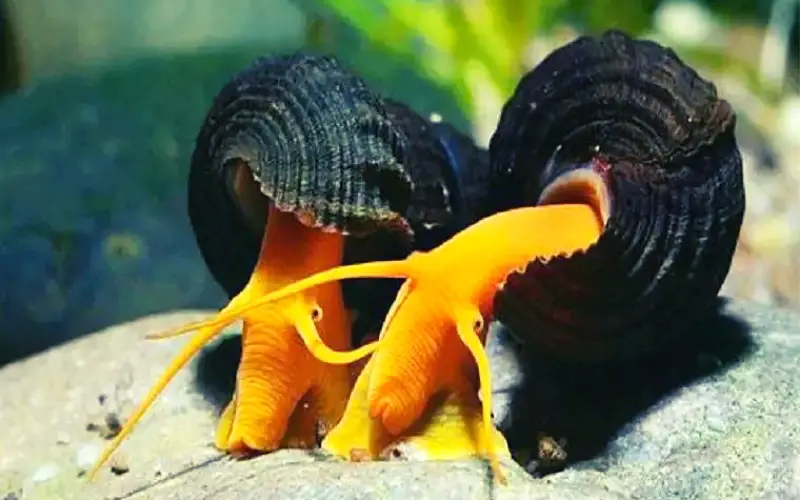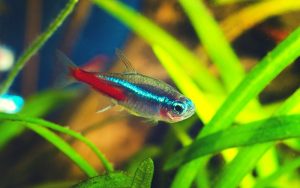Are you considering adding rabbit snails to your collection of aquatic pets? Making sure you have the right tank size and setup is crucial to their health and well-being. So, what is the perfect rabbit snail tank size for thriving healthy?
In this ultimate rabbit snail care guide, we will delve into the world of yellow rabbit snails and explore the ideal tank size and conditions for these fascinating creatures.
Rabbit snails, also known as Tylomelania, are a unique species of freshwater snails that are becoming increasingly popular among aquarium enthusiasts.
These snails are known for their distinctive appearance and gentle nature, making them a great addition to any aquarium setup.

To ensure your rabbit snails thrive in their new environment, it is essential to provide them with the proper tank size for rabbit snail. From water parameters to substrate choices, we will cover everything you need to know to set up the perfect aquarium for your rabbit snails.
So, let’s dive in and create a happy and healthy habitat for these charming little creatures!
Table of Contents
ToggleWhat Size Tank Does a Chocolate Rabbit Snail Need?
Chocolate rabbit snails are active and relatively large snails, so they need a good amount of space to thrive. The minimum recommended tank size for a chocolate rabbit snail is 20 gallons.
Here’s some additional info to consider:
- Tank size for multiple snails: If you plan on keeping multiple chocolate rabbit snails, you’ll need to increase the tank size accordingly. A good rule of thumb is to allow for 2 gallons of tank space per snail.
- Tankmates: Chocolate rabbit snails are generally peaceful community tank dwellers. However, avoid housing them with aggressive fish, such as betta fish, that might prey on them.
- Lid: Chocolate rabbit snails are curious explorers and can escape from tanks if not adequately secured. Make sure your tank has a tight-fitting lid.
Rabbit Snail Minimum Tank Size
When considering the minimum tank size for Rabbit Snails, it is essential to take into account their size and behavior. These snails can grow up to 3 inches long, so they need ample space to move around and explore.
A general rule of thumb is to provide at least 10 gallons of water for each snail, plus extra space for any tank mates you may have.
Rabbit Snails are peaceful creatures that will get along with most other fish and invertebrates, such as shrimp, mystery snails, Nerite snails, Amano shrimp, and more.

They are scavengers that feed on decaying plant matter, leftover fish food, sinking pellets, and algae wafers. It is also essential to provide plenty of places to hide, such as live plants, caves, and pieces of driftwood.
However, keep in mind that Rabbit Snails are larger than many other snail species, so that they can produce a significant amount of waste. You will need to have a good filter system in place to keep the tank’s bioload stable.
Additionally, some tank mates, such as Goldfish or Cichlids, may not be compatible with Rabbit Snails, as they could potentially harm or eat them.
Before adding any new animal to the tank, do some research and seek advice from the aquarist community, articles, or online discussion forums to ensure compatibility and proper care.
If you are interested in breeding Rabbit Snails, they will need a stable environment with adequate warm temperature, clean water, and sufficient food sources to thrive and reproduce. The female snails will lay white egg-like structures on the glass, plants, or other surfaces in the tank.
As the baby snails grow, consider separating them from the main tank to prevent overcrowding and ensure their growth and development. With proper care and attention to their surroundings, Rabbit Snails can be a fascinating addition to your freshwater community tank.
What is The Ideal Rabbit Snail Tank Size?
The ideal tank size for orange poso rabbit snails is around 20 gallons. They are larger snails that need plenty of space to roam and explore. A smaller tank may cause them stress and affect their overall health.
In a 20-gallon tank, you can also house other peaceful tank mates like nerites, ramshorn, or cherry shrimp. It is crucial to provide a well-maintained environment with a stable temperature, proper filtration, and regular water changes to make sure your snails thrive. Additionally, offering vegetables or blanched food will help them stay healthy and happy.
For those wondering if 10 gallon tank would be sufficient for orange Poso rabbit snails, it is generally recommended to go with a larger tank size rabbit snail. These snails are active and will make use of all the space available to them.
In a smaller tank, they may need more room to stretch their shell or explore their surroundings fully. It is always better to give them more room to thrive.
Plus, a larger tank allows for a more stable environment and easier maintenance in the long run. If you need advice on setting up a tank for orange poso rabbit snails, there are plenty of fully formed resources available online.
What To Look For When Buying Rabbit Snails In Stores
When buying rabbit snails in stores, there are a few essential things to consider. Here are some things to look for when purchasing rabbit snails in stores:
- Activity level: Look for snails that are actively moving across hard surfaces or stuck to the glass of the tank. Inactive snails that are lying on the bottom of the tank, upside down, or floating are likely sick or dying.
- Shell condition: The snail’s shell should be thick and free of cracks, deep pits, or excessive wear. Thin, cracked, or worn shells can indicate that the snail is unhealthy or has been in poor water tank conditions, such as water that is acidic or low in calcium.
- Completeness: Rabbit snails may be kept in tanks with fish that might nip at their tentacles. Make sure the snail’s body appears complete and whole, with no missing parts.
By following these tips, you can increase your chances of choosing healthy rabbit snails that will thrive in your aquarium.
Setting Up the Perfect Rabbit Snail Aquariums
The orange elephant snail, also known as the orange giant Sulawesi Indonesia rabbit snail (Tylomelania gemmifera), is a prized addition to any aquarium.
Here’s what you need to know to set up the perfect home for your orange elephant snail:
Tank Requirements:
- Size: Due to their adult size (up to 4.5 inches long!), these snails need a spacious tank. A minimum of a 20-gallon tank is recommended, but even bigger is better.
- Water Parameters:
- Temperature: Aim for a range between 72-82°F (22-28°C).
- pH: Slightly alkaline water is ideal, between 7.2 and 7.8.
- Hardness: They prefer moderately hard water with a GH between 6 and 15 and KH between 4 and 8.
- Filtration: A mature canister filter is ideal for maintaining pristine water conditions.
- Substrate: Opt for a soft substrate like sand or finely-grained gravel. They like to burrow, so a depth of at least 2 inches is recommended.
Natural Habitat:
- Plants: Live java fern plants are highly recommended. They provide hiding spots and grazing opportunities and help maintain good water quality.
- Décor: Add rocks and driftwood to create hiding places and a more natural environment.
Tank Mates:
- Peaceful: Orange elephant snails are quiet creatures. Ideal tank mates include peaceful fish like rasboras, gouramis, and shrimp. Avoid aggressive fish that might nip at the snails.
Feeding:
- Algae: They are primarily algae eaters and will happily munch on algae wafers, biofilm, and algae growth in the tank.
- Supplements: Supplement their diet with sinking fish food or specialized snail food to ensure they get all the nutrients they need.
Additional Tips:
- Lid: A tight-fitting lid is recommended as these snails are known escape artists.
- Acclimation: When introducing your snail to the tank, acclimate them slowly to avoid stress.
- Calcium: Maintain good calcium levels in the water for healthy shell growth.
By following these guidelines, you can create a thriving environment for your orange elephant snail to live a long and healthy life. Remember, research is critical to successful snail keeping. For more in-depth information, consider consulting with experienced aquarists or reputable online sources about caring for Tylomelania gemmifera.
Commonly Asked Questions about Mini Rabbit Snail Tank Size (FAQs)
Do rabbit snails need to be in pairs?
Yes, rabbit snails need a male and female to reproduce. They are not asexual and lay eggs only if both sexes are present in the tank.
Are rabbit snails hard to take care of?
Rabbit snails are generally easy to care for! They thrive in stable aquariums with good water quality and a sandy substrate for burrowing. Avoid copper-based treatments and ensure calcium for strong shells.
How big of an aquarium does a snail need?
The ideal aquarium size for a snail depends on the species. A good rule of thumb is 1 gallon per snail for larger varieties, while smaller snails can thrive in smaller tanks or even critter keepers. Always research the specific needs of your types of rabbit snails!
What size tank does a rabbit snail need?
Rabbit snails thrive in aquariums 20 gallons or larger. Their size and waste production make smaller tanks harder to maintain. For a single snail in a well-maintained tank, 10 gallons can suffice.
How big are chocolate rabbit snails?
Chocolate rabbit snails are relatively large snails for aquariums, reaching up to 4 inches in length as adults. Their long, pointed shells are light brown, while their bodies are a chocolate brown color.
What is the minimum tank size for a snail?
The absolute minimum tank size for a snail is 3-5 gallons, but consider a larger tank for better water quality and easier maintenance. Snails produce waste that impacts the tank’s bioload, requiring more frequent cleaning in smaller tanks.
What is a good tankmate for rabbit snails?
Peaceful fish like tetras and rasboras or shrimp-like cherry shrimp make good tankmates for rabbit snails. Avoid aggressive fish, crustaceans like crayfish and bettas, or other predatory snails like assassin snails.
Conclusion
The rabbit snail, with its mesmerizing colors and adventurous spirit, is a captivating addition to any peaceful community aquarium. But before you bring one (or a few) home, it’s crucial to consider their needs. These slow-moving creatures are surprisingly active and can grow quite large. To keep them happy and thriving, you’ll need to provide ample space for them to explore.
While a well-maintained 10-gallon tank can suffice for a single rabbit snail or a pair, a 20-gallon aquarium or larger is genuinely ideal. Not only will this provide them with room to roam, but it also helps maintain stable water parameters, which is essential for their well-being. So, if you’re looking for an exciting and interactive snail for your tank, the rabbit snail might be the perfect fit. Just remember, when it comes to rabbit snail tank size, bigger is always better!
Top Posts You might like
- Rabbit Snail Breeding 101: A Comprehensive Beginner’s Guide
- How Big Do Rabbit Snails Get in a Tank: (Quick Facts!)
- What Do Rabbit Snails Eat: (5 Foods They Can’t Resist!)
- Golden Rabbit Snail 101: Tank Requirements & Care Tips
- Ultimate Rabbit Snails Care Guide: Tankmates Breeding & More
- Rabbit Snail Colors 101: AMAZING Shades You Won’t Believe!
- Does Rabbit Snail Reproduce Asexually: (The Shocking Truth)
- Will Rabbit Snails Eat Algae: You WON’T Believe What They Do!
- Why is My Rabbit Snail Not Moving in Aquarium: (Troubleshooting Tips)
- Do Rabbit Snails Eat Live Plants in Aquarium: (Experts Advice)
- Keeping Rabbit Snail with Betta Fish Happy (5 Proven Tips)
- Freshwater Rabbit Sized Snail 101: (Tank Size & Care Guide)
- How Many Rabbit Snails Per Gallon: 2 EASY Steps for Success!





